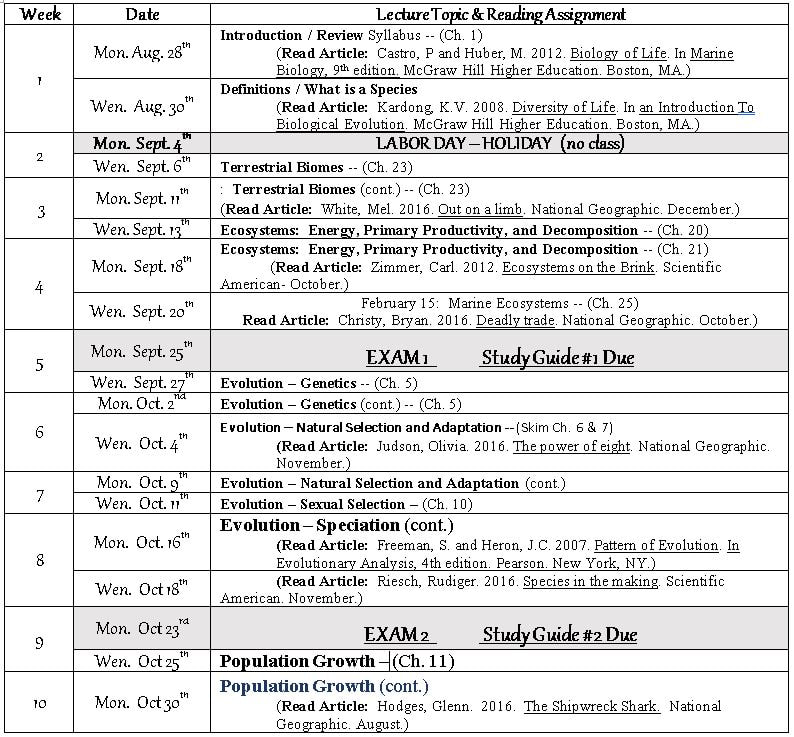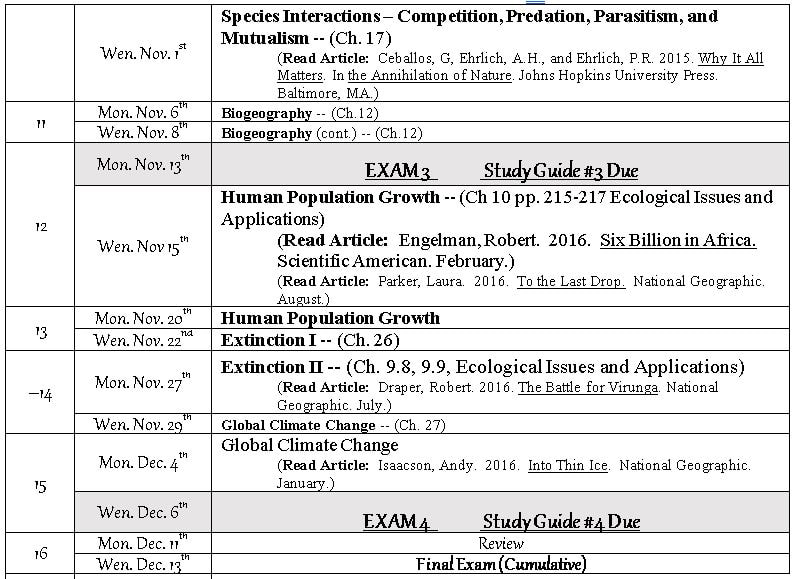WELCOME TO THE ENVIRONMENTAL SCIENCE 105 Syllabus
Course Information
ENVS 105 – Environmental Science 105 Fall 2017 Dates: 08/28/2017 - 12/16/2017
LECTURE CRN 11989
Days: Mondays and Wednesdays
Time: 7:00 am – 8:25 am
Location: BLDG 5 Room 515
Instructor Information
Instructor: Cynthia Sanchez
Course Website: www.scientistcindy.com
Office Hours: by appointment
Course Description
Environmental Biology introduces the student to the basic principles of organismal biology. These principles then are used to assess today’s complex environmental issues. The ultimate concerns in environmental controversies inevitably involve biological processes on the ecological, organismal, and cellular level. This course explores how human-caused environmental changes disrupt the normal conduct of the planet’s biological systems. Core biological principles include: the philosophy of science, photosynthesis, aerobic respiration, genetic resources, protein synthesis, taxonomy of life, evolutionary principles, ecological structures, wildlife management, and human health. The core topics will be treated in a framework of the following environmental issues: loss of species, human population growth, air pollution, water pollution, energy use, resource consumption, and hazardous chemicals.
Student Learning Outcome (SLOs):
Definition: behavioral objective that describes what a student will be able to do or know at the conclusion of a course.
Upon successful completion of ENVS 105 Environmental Biology, the student will be able to...
1) judge claims by using the language, practice and philosophy of science.
2)identify and explain complex biological system dynamics, on multiple scales, based on resource flow modeling.
3) identify and explain the consequences, on multiple scales, of human-caused disruptions of natural biological and environmental systems.
Required Text:
Smith, T.M. and R.L. Smith. 2015.
Elements of Ecology, 9th Edition.
Benjamin Cummings. San Francisco, CA. USA.
ISBN-13 9780321934185
Assignments and Grading Policy:
Grades in this course will be based on examinations and study guides. Examinations may include material from lectures, the textbook, videos, study questions sets, and outside readings.
The grade breakdown is as follows:
grade breakdown is:
Exam I - 50 points
Exam II - 50 points
Exam III (25 New / 25 Review) - 50 points
Exam IV - 50 points
Final - 50 points
Study Guide (4 @ 5 pts) - 20 points
Total= 270 points
Grading Scale
100 – 90% = A
89 - 80% = B
79 - 70% = C
69 - 60% = D
< 60% = F
Course grades that are submitted to the college are final and will not be changed. Students are responsible for knowing their grades for all graded material and ensuring that grades have been accurately recorded by the professor.
Exams:
Exams will consist of multiple choice type questions. The final exam will be cumulative. I encourage you to form study groups to prepare for exams. During exams, I expect the highest academic integrity from all students. You may not speak with your neighbor, look at your neighbors answers, allow your neighbor to look at your answers, consult any notes, or participate in any other activities that could be construed as cheating. Headphones and cell phones are not allowed at exams. Students caught cheating will be referred to the college for disciplinary action. Plan for exams. You may not leave the classroom and return during an exam. Please take care of all personal needs before or after an exam. You will need multiple choice Scantron answer sheets for each exam (Form #882, 50 questions on each side). Students who are more than 10 minutes late on the day of an exam may not be allowed to take the exam. A makeup exam may be scheduled with appropriate written excuse.
Missed Exams:
Students who will miss an exam must notify me prior to the exam or have an acceptable written excuse (i.e. doctor’s note, etc.). Students who miss an exam with an acceptable excuse may be allowed to take a makeup exam. Make up exams may be different from those taken at scheduled exam times. Please note the date of the final exam posted in the schedule of classes. The final exam will not be administered early.
Academic Integrity:
Students are encouraged to share intellectual views and discuss freely the principles and applications of the course materials. However, graded exercises must be executed independently. This course operates under the Fullerton College Policy on Academic Honesty.
Study Guides:
I encourage you to form study groups and work together on developing an understanding of course concepts. You may discuss the answers to study questions with your class mates, but each student is responsible for turning in his/her own work. Answers to all study questions must be typed and in the author’s own words. Study questions must be complete and conscientiously answered to be graded. Question sets are available in the Files folder of the course webpage on MyGateway. Study guides will not be returned to students. You may stop by office hours to check your grade. Late assignments will not be accepted!
Late Work Policy:
Late assignments will not be accepted. Do not fail to turn in Study Guide assignments. They are worth 7% of your grade!
Reading Articles: Reading articles are available through the EBSCOhost database by pasting this link:
http://ezproxy.fcclib.nocccd.edu/login?url=http://search.ebscohost.com/login.aspx?authtype=ip,uid&group=main
After entering your student ID and Last Name, Click on EBSCO Host, then Click on Academic Search Premier. Search article by title and author to find the assigned articles.
Attendance:
You are expected to attend all course meetings and to complete all assigned readings, assignments, and exams. Material may be discussed in class that is not in the book and visa versa. You are responsible for all material covered in lectures, readings, and class assignments. You are responsible for any announcements made in class, including schedule changes and assignments, whether you were present in that class session or not. If you must miss class, make sure to get the notes from another student. You are not likely to do well on exams if you do not attend class. I reserve the right to drop any student who misses more than 2 class meetings.
Course Withdrawal: Students withdrawing from this course should notify the instructor prior to non-attendance in class and must execute drop or withdrawal procedures in accordance with Fullerton College withdrawal policies. It is the student’s responsibility to withdraw himself/herself from the course.
Student Responsibilities:
Students are responsible for conducting themselves in a mature responsible manner. Readings should be completed prior to the class session for which they are assigned. All work should be turned in on time and typed. Students should behave respectfully toward the instructor and other students at all times. While in class, please participate and give your full attention to the instructor. Students talking, text messaging, reading, studying for other courses, or in any other way distracting the professor or other students will be asked to leave the class.
Incomplete Policy: Any incomplete grade must be verified with a written agreement between the student and instructor and follow proper Fullerton College incomplete policies. Incompletes must be arranged with the professor before final grades have been submitted.
Grievance Procedures:
Please refer to the Fullerton College Catalog sections on Student Complaint Procedures and Grade Appeal Request Procedures.
ADA Statement:
Fullerton College is committed to providing educational accommodations for students with disabilities upon timely request by the student to the instructor. Verification of the disability must also be provided. The Disabled Student Services Center functions as a resource for students and faculty in the determination and provision of the accommodations.
Emergency Response Message:
Please take note of the safety features in and close to your classroom, as well as study the posted evacuation route. The most direct route of egress may not be the safest because of the existence of roofing tiles or other potentially hazardous conditions. Similarly, running out of the building can also be dangerous during severe earthquakes. During strong quakes the recommended response is to duck - - cover - - and hold until the shaking stops. Follow the guidance of your instructor. You are asked to go to the designated assembly area. Your cooperation during emergencies can minimize the possibility of injury to yourself and others.
If I Am Not Present at the Beginning of Class: The college expects students to wait at least 15 minutes after the official class start time, before assuming that the professor is not coming and that class has been cancelled.
Suggested Study Strategies:
Read and outline all assigned sections in the textbook. Read and outline all assigned reading articles.Complete all course Study Questions. See professor during his office hours if you have any questions. Copy over all lecture notes following the completion of each course topic. Check for understanding and completeness of notes. Reread textbook or see professor during his office hours if you have any questions. Make flash cards with questions or topics on front side and answers on back side.
Self-test using flash cards. Write down the answers to questions that you get wrong. Continue to repeat flash cards, writing down answers to questions that you get wrong, until you feel comfortable with all material. Use course study questions as a study aid. Consider forming study groups with other students. Enter study group prepared and stay on topic.
Test Taking Strategies:
Enter test well-prepared. Take your time. Read each question and all answers thoroughly. Choose the best answer. You may write on the exams. If you know an answer is wrong, cross it off. If you know an answer is right, circle it. If one or more answers are right, the answer cannot be None of the Above. If more than one answer is right, the answer may be All of the Above. If you do not know the answer, look for related questions elsewhere on the exam that my help you answer the question that you are having trouble with. Graph, Diagram, or Calculate the answer when necessary. Do not over-think the question or answers. Answer all questions.
*****STUDENTS ARE RESPONSIBLE FOR ANY CHANGES TO THIS SYLLABUS
Important dates:
Last Day to Drop Semester Length Classes with a “W” Open registration August 15, 2017 - August 18, 2017
Drop for Non-Payment August 1, 2017 (11 pm) August 15, 2017 (11 pm)
Last day to add with an add code Deadline Full term courses (8/19/17 - 12/9/17) - September 1, 2017
Important dates:
Last Day to Drop Semester Length Classes with a “W” Open registration August 15, 2017 - August 18, 2017
Drop for Non-Payment August 1, 2017 (11 pm) August 15, 2017 (11 pm)
Last day to add with an add code Deadline Full term courses (8/19/17 - 12/9/17) - September 1, 2017


